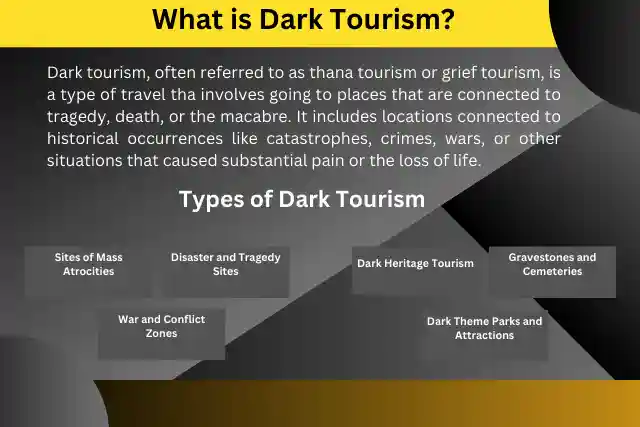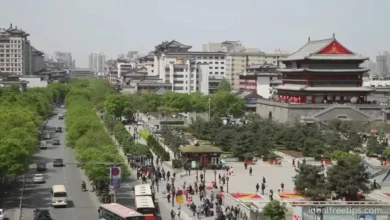
What is dark tourism and why is it so important?
Dark tourism, also known as thana tourism or grief tourism, has emerged as a distinctive form of travel that involves visiting sites associated with tragedy, death, or the macabre. This article delves into the concept of dark tourism, exploring its various types, motivations, and the ethical considerations it raises.
Additionally, it highlights the importance of dark tourism in terms of education, commemoration, reflection, preservation of historical sites, and economic development. By examining the complex relationship between tourism, history, memory, and human curiosity, this article aims to provide a comprehensive overview of dark tourism and its significance in contemporary society.
Define Dark Tourism?
Dark tourism, often referred to as thana tourism or grief tourism, is a type of travel that involves going to places that are connected to tragedy, death, or the macabre. It includes locations connected to historical occurrences like catastrophes, crimes, wars, or other situations that caused substantial pain or the loss of life.
Types of Dark Tourism
Dark tourism encompasses various types of destinations and attractions that attract visitors interested in death, tragedy, and suffering. Some of the prominent types of dark tourism include.
- Sites of Mass Atrocities
- Disaster and Tragedy Sites
- War and Conflict Zones
- Dark Heritage Tourism
- Gravestones and Cemeteries
- Dark Theme Parks and Attractions
Sites of Mass Atrocities
These include locations associated with genocides, such as the Auschwitz-Birkenau concentration camp in Poland or the Killing Fields in Cambodia. Visitors come to learn about and commemorate the victims of historical atrocities.
Disaster and Tragedy Sites
These are places affected by natural or human-made disasters, such as Chernobyl in Ukraine, Pompeii in Italy, or the 9/11 Memorial in New York City. Tourists visit these sites to witness the aftermath and understand the impact of such events.
War and Conflict Zones
These include battlefields, war memorials, and military museums like the Normandy beaches in France or the Vietnam War sites in Vietnam. Visitors explore these sites to learn about military history, pay respects to fallen soldiers, or gain insights into the realities of war.
Dark Heritage Tourism
This type of tourism involves visiting locations associated with infamous individuals, criminal activities, or notorious events. Examples include Alcatraz Island prison in the United States, Jack the Ripper tours in London, or the Pablo Escobar tours in Colombia.
Gravestones and Cemeteries
Certain gravestones and cemeteries, such as Pere Lachaise Cemetery in Paris or Arlington National Cemetery in the United States, attract tourists interested in paying respects to notable individuals, exploring funerary art, or connecting with historical figures.
Dark Theme Parks and Attractions
Some amusement parks and attractions focus on dark themes, incorporating elements of horror, the supernatural, or haunted experiences. These include places like the Catacombs of Paris, London Dungeon, or the Ghost Town in China.
Concept of Dark Tourism
Dark tourism, also known as grief tourism or thana tourism, refers to the act of visiting sites or engaging in activities associated with death, tragedy, or dark historical events. It involves exploring locations that have a morbid or somber significance, often linked to human suffering, disaster, war, or other macabre subjects.
The concept of dark tourism revolves around the fascination humans have with the darker aspects of history and their curiosity to understand and engage with these events. It encompasses a wide range of destinations and attractions, such as memorials, battlefields, genocide sites, cemeteries, prisons, concentration camps, disaster zones, and even crime scenes.
While motivations for engaging in dark tourism can vary among individuals, some common reasons include historical and educational interests, a desire for personal reflection or remembrance, an attempt to confront and understand the human capacity for evil or tragedy, and the thrill of experiencing something out of the ordinary.
Dark tourism can be seen as a form of cultural and heritage tourism, as it involves engaging with sites and narratives that have historical, cultural, and social significance. However, it also raises ethical and moral considerations due to the sensitive nature of the subject matter and the potential for exploitation or disrespect.
Proponents argue that dark tourism serves as a means to educate, commemorate, and remember past events, fostering empathy and understanding. Critics, on the other hand, raise concerns about the commodification of tragedy, the potential for voyeurism, and the need for appropriate interpretation and respect when visiting such sites.
Dark tourism reflects the complex relationship between tourism, history, memory, and human curiosity, prompting discussions about the ethics, motivations, and impacts associated with visiting places of dark significance.
Importance of Dark Tourism
Dark tourism plays a significant role in promoting understanding, preserving history, fostering empathy, and supporting local communities. It offers an opportunity to confront the past, learn from it, and create meaningful connections between people and historical events.
Dark tourism is important for several reasons.
- Education and Awareness
- Commemoration and Remembrance
- Reflection and Empathy
- Preservation of Historical Sites
- Economic and Community Development
Education and Awareness
Dark tourism provides an opportunity for people to learn about and understand the darker aspects of history. It allows visitors to gain insights into past events, their causes, and their consequences, promoting a deeper understanding of human experiences and societal issues.
Commemoration and Remembrance
Many dark tourism sites serve as memorials or places of remembrance for victims of tragic events. By visiting these sites, individuals can pay tribute, honor the memory of those affected, and keep the stories alive for future generations.
Reflection and Empathy
Engaging with dark tourism can evoke a sense of reflection and empathy. It allows visitors to contemplate the human condition, confront the reality of suffering, and empathize with the experiences of others. This can foster greater compassion and empathy towards others.
Preservation of Historical Sites
Dark tourism can contribute to the preservation and maintenance of historical sites that might otherwise be neglected or forgotten. By attracting visitors, these sites can receive financial support for restoration and conservation efforts.
Economic and Community Development
Dark tourism has the potential to stimulate economic growth in communities surrounding these sites. Visitors may contribute to the local economy by spending on accommodations, restaurants, transportation, and local businesses, creating job opportunities and promoting sustainable development.
However, it is crucial to approach dark tourism with sensitivity and respect. Ethical considerations must be taken into account to ensure that the sites are treated with dignity, the stories are accurately and respectfully portrayed, and the experiences do not trivialize or exploit the suffering of those involved.
Conclusion
Dark tourism offers a means to explore and engage with sites connected to tragedy, death, and historical events of significance. It serves as a platform for education, commemoration, reflection, and preservation. By visiting these sites, individuals can gain a deeper understanding of the past, pay homage to victims, foster empathy, and contribute to local communities.
However, it is essential to approach dark tourism with sensitivity, ensuring ethical practices and respectful engagement.
Dark tourism serves as a powerful tool for learning from history and creating meaningful connections with the events that have shaped our world.
You may like:
International year of sustainable tourism for development




